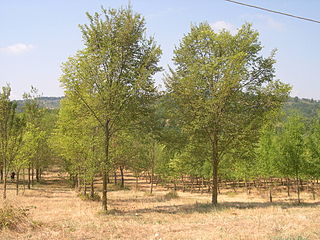
Alternaria is a genus of Deuteromycetes fungi. All species are known as major plant pathogens. They are also common allergens in humans, growing indoors and causing hay fever or hypersensitivity reactions that sometimes lead to asthma. They are present in the human mycobiome and readily cause opportunistic infections in immunocompromised people such as AIDS patients.

Ulmus 'Arno' is an Italian hybrid cultivar derived from a crossing of 'Plantyn' with the Siberian Elm Ulmus pumila clone S.2. It was raised by the Istituto per la Protezione delle Piante (IPP) in Florence, and released in 2007. However, 'Arno' was not a commercial success; propagation had ceased by 2010, and it is no longer patent protected.

Cercospora is a genus of ascomycete fungi. Most species have no known sexual stage, and when the sexual stage is identified, it is in the genus Mycosphaerella. Most species of this genus cause plant diseases, and form leaf spots. It is a relatively well-studied genus of fungi, but there are countless species not yet described, and there is still much to learn about the best-known members of the genus.

The genus Phallus, commonly known as stinkhorns, is a group of basidiomycetes which produce a phallic, often foul-scented mushroom, from which their name is derived. The genus has a widespread distribution and, according to a 2008 estimate, contains 18 species. They belong to the family Phallaceae in the order Phallales. The best known species is the common stinkhorn.

Silver leaf is a fungal disease of trees caused by the fungal plant pathogen Chondrostereum purpureum. It attacks most species of the rose family Rosaceae, particularly the genus Prunus. The disease is progressive and often fatal. The common name is taken from the progressive silvering of leaves on affected branches. It is spread by airborne spores landing on freshly exposed sapwood. For this reason cherries and plums are pruned in summer, when spores are least likely to be present and when disease is visible. Silver Leaf can also happen on poming fruits like apples and pears. Plums are especially vulnerable.
Mycena citricolor is a species of mushroom-forming fungus in the family Mycenaceae. It is a plant pathogen producing leaf spots on coffee plants. This fungus causes the disease commonly known as American Leaf Spot. Mycena citricolor affects coffee plants, primarily in Latin America, but can grow on other plants as well. This fungus can grow on all parts of the coffee plant including the leaves, stems and fruits. When grown on the leaves, Mycena citricolor results in leaves with holes that often fall from the plant.

Corynespora cassiicola is a species of fungus well known as a plant pathogen. It is a sac fungus in the family Corynesporascaceae. It is the type species of the genus Corynespora.

Cercospora capsici is a species of fungus in the family Mycosphaerellaceae. It is a plant pathogen that causes leaf spot, known as frogeye spot, on peppers.
Rhytisma vitis is a species of fungus in the family Rhytismataceae. It was described by Lewis David de Schweinitz in 1832.
Microdochium panattonianum is a fungal plant pathogen. This pathogen causes anthracnose of lettuce, a disease which produces necrotic lesions in cultivated lettuce. In extended periods of wet weather, M. panattonianum can cause significant crop-losses. The impact of this pathogen is exacerbated by farming lettuce without crop rotation, and by planting of susceptible lettuce varieties, such as Romaine lettuce.

Puccinia recondita is a fungus species and plant pathogen belonging to the order of Pucciniales and family Pucciniaceae.

Gymnopilus purpuratus is a species of agaric fungus in the family Hymenogastraceae. It grows in clusters on dead wood, tree stumps and wood chip mulch. It is widely distributed and has been recorded in Argentina, Australia, Chile, New Zealand, the UK and Germany. It has a broadly convex cap covered in small dry reddish-brown scales, a stout yellow stem beneath reddish brown, wine-red to purple vertical fibres, and a thick rusty orange spore print.

Rhytisma acerinum is a plant pathogen that commonly affects sycamores and maples in late summer and autumn, causing tar spot. Tar spot does not usually have an adverse effect on the trees' long-term health. R. acerinum is an Ascomycete fungus that locally infects the leaves of trees and is a biotrophic parasite. The disease is cosmetic and is therefore usually controlled only with sanitation methods.

Arthothelium is a genus of lichenized fungi in the family Arthoniaceae.

Rhytisma is a genus of fungi in the Rhytismataceae family commonly known as 'tar spot'. There are about 18 species, which live parasitically in the leaves of deciduous trees.

Rhytisma ulmi is a species of fungus commonly found on elms in North America

Puccinia poarum, a species of fungus, known as the coltsfoot gall rust, or meadow grass rust, is a plant pathogen. This fungal parasite forms a yellow to orange gall, 1–2 cm in diameter, on the underside of leaves of coltsfoot. It also infects but does not gall grasses of the family Poaceae. P. poarum is a genetically diverse species that has been reported on at least seventy plant hosts. It was originally found on Poa fertilis and Poa nemoralis in Denmark in 1877.

Microsorum punctatum is a fern from the subfamily Microsoroideae commonly called the fishtail fern. It has been used in traditional medicine.

Cristulariella depraedans, commonly known as gray mold spot, sycamore leaf spot or bull's eye spot, is a fungal pathogen that affects maple trees and certain other woody and herbaceous species. In maples, the foliage becomes affected by small grey lesions which expand and coalesce, the leaves later wilting and falling from the tree early. The disease seems to be associated with cool wet summers, and epidemic years sometimes occur.
Blumeriella kerriae is a species of fungus in the family Drepanopezizaceae.
















